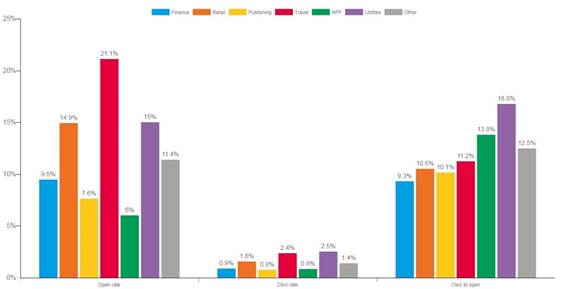According to the DMA’s latest Email benchmarking report 2017, sponsored by dotmailer, delivery rates remained high and open rates continued to be strong in 2016, with the most opened emails coming from travel (21.1%), utilities (15.0%) and retail (14.9%) brands.
The figures demonstrate a disparity between the perceptions of customers and the experiences of marketers. Despite industry open rates of 14.2% in the Consumer Email Tracker 2016 consumers reported that they opened between 28.4% and 50.08% of their emails, between double and four times the number that Email Service Providers (ESP’s) are recording. Nevertheless, users estimate they open at least double the percentage of emails they actually do based on these figures.

Marcus Gearey, Chair of the DMA Email council’s research hub and Analytics manager at Zeta Global, said: “With more than twice as many contributors than at its relaunch last year, the DMA Email benchmarking report is a testament not only to those who volunteered their data – for which we give enormous thanks – but to the inherent value of the report these contributions reflect. As the only report of its type, the more contributors we have, the more legitimate the benchmark becomes. We hope you find it useful.”
Sector performance
According to the report, the top three most opened emails were from travel (21.1%), utilities (15.0%) and retail (14.9%) brands. The least opened categories were not-for-profit (6.0%), publishing (7.6%) and finance (9.5%), raising concerns about the relevance of these emails as they reach the consumers’ inbox. When it comes to clicks, the top performing sector is utilities, with 2.5% winning clicks, followed by travel with 2.4%. The lowest performing sector when it came to click through rates are publishing (0.77%), not-for-profit (0.83%) and finance (0.88%), echoing the pattern observed in open rates.
For the first time, this report collected email metrics for B2B and B2C emails, revealing that B2B emails are slightly more likely to be opened (22.0% for B2B, versus 18.7% for B2C). However, B2C emails receive 57% more unique clicks than their B2B counterparts (2.3% for B2C vs 1.3% for B2B).
Jenna Tiffany, a member of the DMA Email council’s research hub and Founder & Strategy Director at Let’sTalk Strategy, said: “It’s always insightful to see a comparison across industries for email performance. To add context, a large percentage of utilities emails sent are statements or bills, as a result they generate a high open and click rate as customers click to check them. Talking more generally, offers do still play a key part in B2C email content, which typically drives a higher open and click rates. This is especially true with more frequent purchases, unlike in B2B where the purchase cycle is longer. It’s also important to take into consideration when comparing B2B and B2C emails that, typically, a higher proportion of B2B emails are follow-ups or ‘FYIs’ to a conversation that’s recently taken place – such as after a telephone call – which require no action from the recipient, hence the lower click rate.”


To find out more about the research, visit: https://dma.org.uk/article/email-benchmarking-report-2017
Methodology
Data were kindly provided voluntarily by DMA members. The sample covers over 37 billion emails sent by 12 different ESPs: Adestra, Adsalsa, Cheetah, Communicator, Connect Direct, dotmailer, EmailCenter, Emarsys, NP6, Redeye, Traction Digital and Zeta. These participants have a wide range of clients across various industries at disparate volumes; this report should be used as a guideline only for email performance. Only aggregate figures are reported.
Analysis was carried out by the DMA insight team. The report was written by the DMA insight and marketing teams, and the DMAs email research hub.
